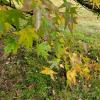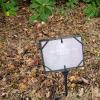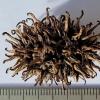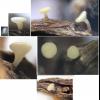
19-12-2025 10:10
Patrice TANCHAUDBonjour, récolte réalisée en milieu dunaire, a

18-12-2025 17:23
 Bruno Coué
Bruno Coué
Bonjour,je serais heureux d'avoir votre avis sur c

18-12-2025 21:17
Pol DebaenstThe identification took me to Byssonectria deformi

18-12-2025 18:07
Margot en Geert VullingsThese plumes were found on rotten wood.They strong

17-12-2025 18:35
 Michel Hairaud
Michel Hairaud
Bonjour à tous/Hi to everyone I am passing along

15-12-2025 15:48
 Danny Newman
Danny Newman
Melanospora cf. lagenaria on old, rotting, fallen

15-12-2025 15:54
 Johan Boonefaes
Johan Boonefaes
Unknown anamorph found on the ground in coastal sa

15-12-2025 21:11
 Hardware Tony
Hardware Tony
Small clavate hairs, negative croziers and IKI bb

15-12-2025 07:09
 Danny Newman
Danny Newman
indet. Rutstroemiaceae sp. on unk. fallen leavesMc
• I cant really separate it from observations of H. fructigenus on various woody fruits, but the apos are small compared to the examples I've seen on acorns, the spores are longer and seem elongated, less scutuloid, and do not have a central restriction.
• I looked at other species in the group but the substrate is difficult and some characters did not seem to fit.
• I found one observation of H. fructigenus on fruits of Liquidambar from the US, but it is not verifiable as there is only one low resolution photo: https://mushroomobserver.org/observations/560994
Habitat: On (woody) fruit capsules of cultivated Liquidambar (Altingiaceae, non-native), labelled L. styraciflua 'Worplesdon', capsules still attached to composite fruit ball, on the floor, amongst leaf litter, under the tree, presumably xeric, small tree, between a lawn and a (slightly) more natural wooded area, private garden, High Weald, south England, mid-October, after rain.
Associates: Some black spherical and erumpent fruiting bodies, abundant short hyphae protruding from the substrate after some time in a damp box.
Apothecia: Several on the same fruit ball, 1(-2) per capsule, not caespitose, diameter < ~0.5 mm, height similar, whitish then yellowish, orangish when dry/overmature, cupulate to discoid, short stipe, narrow or obconical.
Low magnification: Slightly pruinose appearance, receptacle with yellowish-orangish patches, margin round, when young protruding above the disc with short whitish hairs, eventually out-rolled, resp. disc initially concave, eventually plano-convex, sometimes slightly umbilical, more yellow, stipe more translucent, with very short hairs, orangish around the base, soft-gelatinous texture when sliced, internally with medullary area more whitish and opaque, resp. receptacle and stipe more translucent.
Asci: Cylindrical-clavate, simple septa, rings weakly bb, Hymenoscyphus-type, apex rounded-conical when turgid, conical-subtruncate with shallow thickening when flaccid, thickening more dome-like when immature, some light exudate on top, after discharge with large collar-like opening, 2-2.5 seriate when turgid, sensitive to disturbance, soon abundantly discharging in water mount.
Spores: Elongated-lacrymoid, length variable, heteropolar with apex round and base acute-pointed, slightly scuteloid and slightly inequilateral or curved in profile view, uninucleate, aseptate, with ~3 medium-size LBs towards each pole (often 3 above the nucleus and 4 below) and several smaller ones, 0-2 (3?) short seta seen at the ends, occasionally a small outgrowth from one end, quite sensitive to disturbance.
Free living mature spores in water: (22.1) 22.7-27.0 (30.1) × (4.6) 4.7-5.3 (5.4) µm, Q = (4.4) 4.5 - 5.6 (6.1), N = 23, mean = 24.7 × 5.0 µm, Q mean = 5.0.
Paraphyses: Narrow cylindrical, uninflated at the apex, no branching above the base observed, Hymenoscyphus-type VBs.
Medullary and excipulum: Structure comparable to H. fructigenus, marginal cells with slightly clavate-capitate apices, with orange-yellow pigment/exudate in external network of hyphae and marginal cells.

I was conflicted over the spores that looked closer to H. scutula, the substrate, and the variance of spores across H. fructigenus. Unfortunately, I did not look at H. fucatus and it seems this was due to the lack of croziers.

I thought the setulae were too short (and maybe the number too variable) for H. scutula and the spores different to H. virgultorum too.






 Sections-0010.jpeg
Sections-0010.jpeg